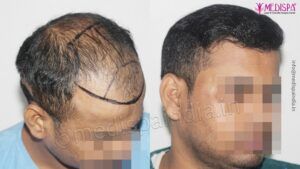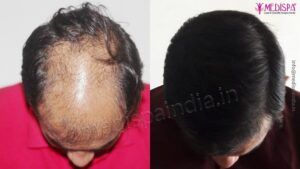
What is the nature of your hair loss? Is it permanent or temporary? If you have a family history of hair loss, it is likely that your hair loss is permanent. To confirm the nature of your hair loss, it is recommended to consult a doctor and find the most suitable treatment solution. Currently, hair transplant is considered the most effective way to address baldness. However, it is important to determine if it is truly worth it.
Let’s delve into the details of pattern baldness and how to overcome it. Hair transplant has gained recognition as the most effective treatment for hair loss. Its popularity extends worldwide, with India being recognized as one of the top destinations for hair transplant tourism. The affordability and high-quality treatment offered in India attract people from all over the world, providing them with a wonderful experience of hair transplant.
In the Western world, hair transplant procedures are often expensive and not covered by medical health insurance. This is why many people choose to seek treatment in other countries, particularly India. The hair transplant cost in Jaipur and Delhi is affordable and renowned for its exceptional hair transplant industry, making it the preferred choice for many seeking hair transplant tourism. Both Delhi and Jaipur are known for its expertise in hair transplant procedures, with several reputable clinics offering world-class standards at an affordable cost.
If you are searching for the best hair transplant in Jaipur, it is advisable to opt for the more preferred route, which is to visit the top clinic like Medispa.
Medispa hair transplant clinic is a leading center for hair transplant in India. We have catered to numerous celebrities, high-profile patients, and everyday individuals. Every patient is treated like a celebrity, and our focus is on providing the most natural-looking hair transplant results. Our expertise and experience are evident in our excellent work. We encourage you to review our before and after images of previous patients to assess our skills.
Stages of pattern baldness?
The extent of baldness can be categorized into seven stages using the Norwood classification, which provides a comprehensive explanation of hair loss. The following are the seven stages of hair loss:
Class I: Entire hairline lies high on the forehead and is not actually balding.
Class II: Triangular areas of recession in the sides of frontal area and minimal recession on mid frontal area.
Class III: Borderline case. Deepening of triangular recession or can include thinning of hair on the vertex.
Class IV: Further frontal hair loss and widening of hair loss from vertex but still a wide band of hair present separating frontal and vertex hair loss.
Class V: Widening of frontal and vertex hair loss and continual breaking of separation line of hairs between frontal and vertex baldness.
Class VI: Band or bridge of hair disappear merging frontal and vertex baldness.
Class VII: A band ofhair presents only in back and side of the head.
Possibilities to treat hair loss
There are various options available for treating hair loss. These include medications, PRP therapy, and hair transplant procedures. Medications can provide some benefits, but the results are often temporary and the condition may worsen once the medication is discontinued. PRP therapy is recommended for early-stage hair loss and has shown some benefits, although its effectiveness is limited for advanced hair loss. Hair transplant procedures have emerged as the most effective solution for baldness. This procedure involves transferring hair roots from a donor area to the desired bald area, resulting in the restoration of hair.
Hair Transplantation
The surgical procedure involves extracting hair roots or follicles that are not sensitive to DHT and are therefore permanent. These follicles are then transplanted to the bald area, providing a permanent solution for pattern baldness. The selection of these roots is based on two criteria: permanent hair roots and reasonable hair density. Typically, the back and sides of the head are chosen as the donor area, but in cases where there is a lack of follicles in these areas, body hair can also be used. The success of the hair transplant depends on the design of the hairline and the rate of damage to the hair follicles during the procedure.
There are two main techniques used to extract the hair follicles: FUT (Follicular Unit Transplantation) and FUE (Follicular Unit Extraction). FUT involves harvesting a thin strip of scalp tissue with hair follicles, which is then dissected under microscopes to isolate individual grafts. FUE, on the other hand, involves extracting individual hair follicles using a punch-like device and placing them at the target bald site.
The principle behind hair transplant involves surgically removing hair from areas where the hair roots are permanent and then implanting them in the bald area. The hair roots located at the back and sides of the head are preferred because they are resistant to DHT (dihydrotestosterone) and do not undergo thinning caused by this hormone due to genetic dysfunction. The genetic composition of the hair lies in the root itself, not on the scalp. Therefore, when hair roots from DHT-resistant areas are transplanted to the bald area, they remain permanent. In cases where there is a lack of hair follicles in the preferred donor area, which is the back and sides of the head, body hairs can be alternatively selected for harvesting.
What are the core benefits of hair transplant procedure?
The treatment of choice for pattern baldness is undoubtedly hair transplant. This procedure provides numerous benefits, which are outlined below:
- Hair transplant guarantees permanent results. If performed by skilled professionals, the hair growth achieved through this procedure lasts a lifetime.
- Hair transplant is a convenient procedure that requires no additional measures for hair growth once the physical recovery is complete.
- It is a painless procedure carried out under local anesthesia.
- The transplantation process utilizes your own hair, resulting in a natural-looking hairline.







